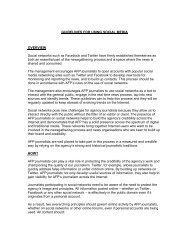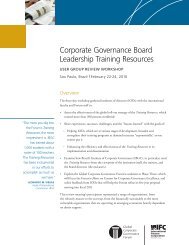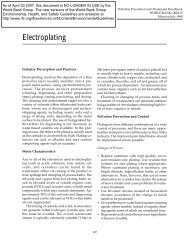A Self-Assessment Guide for Health Care Organizations - IFC
A Self-Assessment Guide for Health Care Organizations - IFC
A Self-Assessment Guide for Health Care Organizations - IFC
You also want an ePaper? Increase the reach of your titles
YUMPU automatically turns print PDFs into web optimized ePapers that Google loves.
Leadership<br />
Systems<br />
Data<br />
Where to Begin<br />
Effective leadership is critical to the<br />
success of quality improvement<br />
ef<strong>for</strong>ts. Leaders provide the direction<br />
and support required to create a<br />
culture of quality. Leadership must<br />
incorporate “Quality” into the<br />
mission, vision and values of the<br />
organization. Leaders must be<br />
“present” and participate in quality<br />
improvement ef<strong>for</strong>ts, such as<br />
participating in quality-related<br />
training, committees, making<br />
rounds 5 , showing interest (e.g. by<br />
asking questions about activities and<br />
results), including Quality<br />
Improvement reports in meeting<br />
agendas, and giving recognition to<br />
individuals and groups.<br />
Hospital services are provided within<br />
a system. The focus must be on<br />
improving the overall system and the<br />
processes within it to create an<br />
environment that meets the needs of<br />
the staff and patients. Quality<br />
standards assist the staff in looking<br />
at the various processes that affect<br />
the quality of care. For example, the<br />
process of maintaining an inventory<br />
has a direct effect on the availability<br />
of drugs. The focus is not on<br />
individual staff members but rather<br />
on how well the system is working<br />
and finding ways to improve it.<br />
Sound decisions are made with the<br />
appropriate in<strong>for</strong>mation. There<strong>for</strong>e,<br />
quality improvement ef<strong>for</strong>ts rely on<br />
collecting data to assess<br />
per<strong>for</strong>mance, to identify strengths<br />
and gaps in per<strong>for</strong>mance, and to<br />
find solutions to improve<br />
per<strong>for</strong>mance and meet set standards.<br />
The measure of success is based on<br />
comparing the baseline<br />
measurement with the measurement<br />
after an improvement has been<br />
implemented.<br />
When asked, health care staff can usually list the types of problems they<br />
face daily in providing patient care. However, often they do not believe<br />
that they have the accountability or power to do anything about it.<br />
And in many organizations, staff members have not been trained in the<br />
Quality Improvement approaches used to investigate and solve problems.<br />
Nonetheless, Quality Improvement methodology is increasingly being<br />
used effectively in many developing countries to help health care teams<br />
to identify problems and to find and implement solutions.<br />
Utilization/workload measures<br />
• No of inpatients<br />
• No of outpatients<br />
• No of procedures (surgical etc)<br />
• No of tests<br />
Efficiency measures<br />
• Average length of stay<br />
• Bed occupancy rate<br />
• Day case rate<br />
• Operating theater utilization<br />
Quality/outcome measures<br />
• Unplanned readmission rates < xx days<br />
• Infections (e.g. MRSA and Clostridium Difficile)<br />
• Patient falls<br />
• Unplanned returns to operating theater<br />
• Needle-stick injuries<br />
• Pressure sores<br />
• Complications rate<br />
• Caesarian rate<br />
• Deaths<br />
• Sentinel events<br />
• Patient complaints<br />
• Patient satisfaction<br />
Often, data such as these are collected, but frequently they are not<br />
aggregated, analyzed and used <strong>for</strong> decision-making. Thus, the first place<br />
to start is with the data that exist. Collating this basic in<strong>for</strong>mation helps<br />
the organization to understand its patient population and provides a<br />
basis <strong>for</strong> planning service delivery and improvement.<br />
Resources<br />
<strong>Organizations</strong> committed to Quality Improvement should familiarize<br />
themselves with the latest Patient Safety Guidance from the World <strong>Health</strong><br />
Organization (WHO). This covers important issues such as Safe Surgery<br />
and Hand Hygiene – and can be found at: www.who.int/patientsafety.<br />
And many useful materials can be found on websites such as that of the<br />
Institute <strong>for</strong> <strong>Health</strong>care Improvement: www.ihi.org<br />
Throughout this <strong>Guide</strong>, useful in<strong>for</strong>mation sources are identified. These<br />
include publications and websites, that may be used to learn and to build<br />
staff capacity. All online resources that are referred to are accessible free<br />
of charge.<br />
The key factor in this process is the use of data to support decisions.<br />
The type of data collected will vary from place to place, but commonly<br />
includes or relates to:<br />
5<br />
Patient Safety First, UK. Leadership <strong>for</strong> Safety, Supplement 1: Patient Safety Walkrounds. Available at:<br />
www.patientsafetyfirst.nhs.uk/ashx/Asset.ashxpath=/How-to-guides-2008-09-19/How%20to%20<strong>Guide</strong>%20<strong>for</strong>%20Leadership%20WalkRounds%20(pdf)<br />
<strong>IFC</strong> <strong>Self</strong>-<strong>Assessment</strong> <strong>Guide</strong> <strong>for</strong> <strong>Health</strong> <strong>Care</strong> <strong>Organizations</strong> 9














![Print a two-page fact sheet on this project [PDF] - IFC](https://img.yumpu.com/43449799/1/190x245/print-a-two-page-fact-sheet-on-this-project-pdf-ifc.jpg?quality=85)


